So far, in our coverage of the Hawthorne Bridge Crash, we’ve heard from an eyewitness and the two people who collided. We’ve also discussed both infrastructure and behavior-based solutions.
But one important party to this issue has been left out: pedestrians.
It’s hard to determine what exactly caused Erica Rothman’s harrowing crash, but it’s likely that the presence of people on foot played a role (Rothman had veered to the left to avoid them). On that note, I’d like to share an idea from Ron Richings. (Richings is the guy I mentioned in my editorial on Tuesday who put quite a bit of thought and advocacy work into this issue last summer.)
“…during rush hours, all pedestrians could be directed to the south sidewalk in the morning and the north sidewalk in the afternoon.”
— Ron Richings
Richings’ idea is based on the premise that people are quite unpredictable when walking, and keeping them away from bikes would increase safety for everyone. In an email to Multnomah County Transportation Planner last summer, he explained his idea like this (emphasis mine):
“Pedestrians however may walk three or more abreast, turn around without warning, stick out an arm leg or whatever, and do a variety of other unpredictable things. And the closing speed between bikes and pedestrians is much greater than between bikes and bikes, so reaction time can be very limited.
Where all this leads is to wonder if, during rush hours, all pedestrians could be directed to the south sidewalk in the morning and the north sidewalk in the afternoon? A slight inconvenience for walkers but potentially a significant increase in safety and utility for cyclists.”
The idea is to reserve the bridge pathway exclusively for bikes in the prime commute direction.
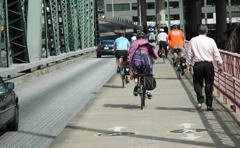
Richings thinks this would not only help cyclists’ plight, but that the “pedestrian re-allocation” would improve their safety as well. He acknowledges that there might be some “initial grumbling” about being re-routed, but that people would quickly adapt. He also points out that there is some very recent precedent for this in his hometown of Vancouver, B.C..
Faced with dangerously narrow, six-foot wide sidewalks shared between bikes and peds (Hawthorne path is 11-feet wide) on each side of the Burrard St. Bridge, the City of Vancouver decided just last week to do a trial of a new configuration: pedestrians and bikes will now each get their own sidewalk (and bikes also get a full lane on the bridge roadway, something that Multnomah County says won’t happen here).

(Graphic: City of Vancouver)
When I brought Richings’ idea up to a planner friend the other night, he said the idea was worth some thought. The biggest push-back he said it might encounter would be from pedestrian advocates who are loathe to endorse anything that creates any level of inconvenience for walkers (can’t blame them for that).
What do you think? The County is looking for suggestions, so perhaps we can help them vet this one out.


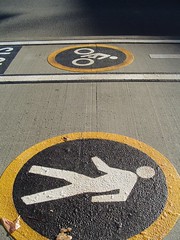
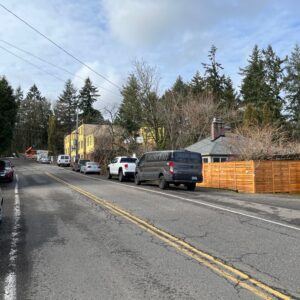
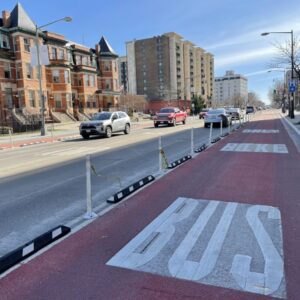
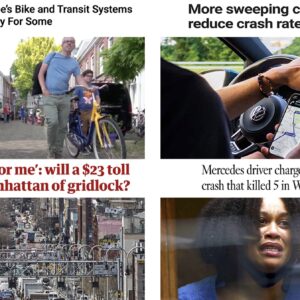
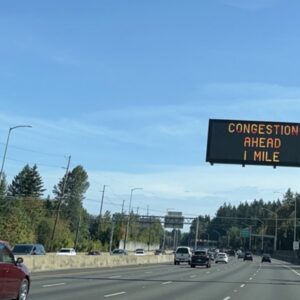
Thanks for reading.
BikePortland has served this community with independent community journalism since 2005. We rely on subscriptions from readers like you to survive. Your financial support is vital in keeping this valuable resource alive and well.
Please subscribe today to strengthen and expand our work.
Sounds like a good and fairly simple solution.
I noticed there was much stress put on the safety of cyclists, but wouldn’t this also be a great safety enhancement for pedestrians as well as the risk of a cyclist/pedestrian collision seems just a possible as a cyclist/cyclist collision?
If safety for all forms of transport across the bridge is the focus of this potential solution one would think it would be hard for any one group to reject it outright.
Too complicated! But good for whomever is thinking about this. Keep at it.
I’ve said before that bike/ped mix is often a problematic one.
But…the distance you’d have to cover on foot to get to the other side is pretty substantial when you’re talking about walking.
And the signage to explain what’s going on would be kind of complicated.
Maybe it’s the least bad solution to a complicated problem, but I think everyone should keep thinking.
Wow, J thank you thank you thank you for some objectivity. Now that’s some BP I’ve come to respect and admire! All I’ve asked is that other factors in this accident be considered. Well, other factors that won’t lead to criminalizing people’s behavior, that is.
Excellent, excellent work. Again, thank you.
Now, in my day we had a heck of a time messing with the peds on this bridge. Is it now felt the time is right for another run? It’s completely an irrational position, I’m the first admitting it, but I’ve always felt the Hawthorne belonged to us bikes. For so long it was the ONLY way, I’ll tell ya.
Our efforts resulted in an outcry though. A really, really, big one. Peds’ position was that it was more work to pick a side to access this bridge, or walk to another one than it was for bikes just to alter their route or riding style.
Has this changed? Are peds willing to give up the bridge a little? I’d be surprised.
To restate my position, I think things are fine just the way they are. Should a concerted effort to look at this incident objectively produce the NEED for some prudent changes, I can get on board with that.
I can’t get behind finger-pointing (Unless it’s at Progressive-Liberal elitists hell bent on helping me whether I need it or not.) and this new consideration is anything but. Thanks again!
I bet enough pedestrians are annoyed by bike traffic on the bridge that they could view this as just as much a benefit to themselves as it would be to cyclists.
Let’s do it! I believe this is akin to what is done at the Golden Gate Bridge does.
Sure, blame it on the peds. Nice.
this is the best solution that I have seen. it is low cost and low inconvenience. it seems so simple to me – not as complicated as some have said.
from first light til 10am(or whatever) – fast traffic goes on the north side; slow traffic goes on the south side.
from 4 til 7pm, fast traffic is rerouted to the north side. this can easily be done with some signs and some education.
do it as a guideline, not a law. in short order, it will become the natural order of things. new people will quickly follow suit.
alternatively, some sort of cycletrack covering those awful grates would alleviate the congestion – but, umm, good luck with that.
why not just dedicate one side for peds, and the other for cyclists, at all times?
(i’m not from portland, so if there is something blatantly wrong with this idea please enlighten me politely)
What about those cyclist going against the flow in this scenario? I suppose you would two-way bike traffic on the one side? Sounds like a bad idea.
Too complicated. Just separate the bike and peds with a continuous painted line. Simplicity is the key.
I think a better idea is to make the inner lanes auto-only, outer lanes bike-only, and sidewalks ped-only.
Unbelievable. Simply Unbelievable. Replace the the word bike with the word car, and word pedestrian with the word bike, and re-read the above article. Still sound like a good idea? You replaced car-head with bike-head.
It is a public right of way. To restrict the the most basic form of transport to appease bicycles is ridiculous. It is public space. It will never be acceptable to me to abridge the right to walk somewhere. Good Grief!
I would feel safer if the walkers were looking at me. So walk in the opposite direction of traffic just like people are supposed to do if they are walking on the road. I think most people who see a biker coming would not wave an arm or step in front of a biker.
It seems in my experience most walkers are walking the same direction as traffic. So they don’t see you coming and maybe startled by a bell or call out. And it’s also harder to say hello.
What ever the change if we asked people to do it for safety during rush hours and most people complied that would make a big difference.
Maybe the city could hand out something to the walkers who walk in the right direction.
Interesting and worth additional analysis but it still appears that we’re working with a system that is over capacity. Suppose we go through the exercise and develop such a system, it’s an incremental improvement for some users.
I wonder if these PBOT officials who immediately discount options as a “non-starter” are jumping the gun. I’m referring to opening up a road lane. Related to the metal grating; while I’m sure that current engineering design norms make creating a new surface too expensive and too heavy, I’m not willing to write it off as impossible.
With material specifications changing and improving all the time, I believe that there are several products that could be installed (be it sheet, roll, etc.) temporarily or permanently for not a lot of money.
More paint, more rules, more education, more enforcement, please! And when that doesn’t work, we can always do even more, and more, and more!
I fully support this idea as i independently came up with it 🙂 Implement ASAP for safety of all, I say! the inconvenience for walkers is roughly 100 steps in the worst case at each side of the bridge.
Would bikes going against the rush still stay where they are used to being under this proposal?
as a lowly ped who walks the bridge:
1) i didn’t know the bikes owned the hawthorne bridge? i didn’t realize we weren’t sharing it with bikes already? its not like other bridges are a picnic for peds either
2) i’ve actually thought about trying to cross the bridge on the other side in the morning, but it is out of my way, and feels like a lot of effort for my in-efficient, earth-bound legs.
3) and if we are going to use a yardstick of “least effort” and simplicity:
– bikes could simply “go slow” and “yield to peds” as the signs say now.
yield is debateable. go slow: all bikes go their cruising speed on bridge. no bike currently slows down in the presence of peds.
– bikes could have rule no passing other bikes in a congested zone, i.e. ride single file, instead of trying to pass each other. that would shave 20 seconds off the commute of the faster bikers? versus the extra few minutes rerouting peds to the other side?
– or in the spirit of trying to change other’s behavior instead of our own: we could make the middle of the hawthrone bridge a walk only zone. bikers would have to walk their bikes across the congested zone. that would be simple to understand. would slow down traffic. be safe. and seems the least “inconvenient” to everyone from my perspective.
4) sorry for the rant, but speaking of unpredictable… i have no idea if a bike is going to pass me from behind inches away, or many feet away. beyond the hawthorne bridge, as we live in a less car centric, it would be nice for us to evolve some basic rules of the road such as the proper way for a bike to pass peds from behind. i suspect we’ll be sharing the same paths for many years to come.
agree about the idea of adapting a car lane to car/bike. I could imagine a few mm thick plastic strip that is 3 foot wide would make this possible.
the speed limit on the bridge is 25, I think. so, the speed devils out there could keep up with the flow of traffic.
agree with the comment on PBOT. people who are good at solving problems do not approach them by taking good options off the table.
If we want to avoid future user conflict, we can’t just keep pretending that both bikes and peds have the right to use the full width of the path at their own discretion and risk. I would vote for a painted line to separate bikes and peds at each side of the bridge. The big question PBOT will need to tackle is how much space to allocate for each user group.
This idea was floated last night in discussion during the Multnomah County Bike / Ped Citizens Advisory Committee, along with other ideas like increased education. The county would need to evaluate any proposed solution before committing to any course of action (note: I don’t speak for the county, I’m voicing a personal opinion as a committee member).
I, likewise am concerned about anything that might reduce access for pedestrians. They have an equal right to that bridge, and any solution that removes the access they currently enjoy would be less than optimal. I agree somewhat with those who say “replace bikes with cars and peds with bikes” – the same arguments can be applied to removing right-of-way from cyclists.
Excellent solution. I couldn’t agree more with this. And to minimize the odd signage and cut-off times, I’d suggest just making it permanent: Pedestrians get the north side; Bikes get the south side.
From either side, there’s perfect, convenient access to the Esplanade, and for Pedestrians walking past Grand Ave., the north side drops them down into the lower SE, allowing them to avoid the “second bridge” with narrow sidewalks.
So, why isn’t a more equitable and equally effective solution to make the inner lanes auto-only, outer lanes bike-only, and sidewalks ped-only?
DJ Hurricane — because we’re not just talking about cars/bikes/peds here. Trimet buses and occasional trucks are also in the mix, and they can’t fit through the center lanes.
It doesn’t seem that complicated to sign, as long as the ped restrictions only apply between the ramps/approaches on the west side and the ramps to the Esplanade on the east side — just put a few “No Peds” or “Peds Not Advised” signs at each end with a time restriction, 7a-9a westbound and 4p-6p eastbound, for example.
It seems like this would be a significant increase in safety and utility for cyclists AND pedestrians. I don’t walk the bridge much (usually I’m on my bike) but I would feel safer reducing the bike/ped interaction.
Also, just because it’s right-of-way doesn’t mean it should not be controlled. The middle of the street is also right-of-way, but we don’t walk in it usually, do we?
Finally, the COUNTY maintains and controls the right-of-way on the Hawthorne Bridge — not PBOT (the City).
No thank you. Here is the order of priority for right-of-way and desire line accommodation: pedestrians, bicyclists, drivers. Transit riders fall off the bottom of the list due to the inflexibility of (re)routing this mode.
The primary circulation factor in the quality-of-life/’livability’ of a city is its ability to accommodate walking in a convenient, secure, and scenic manner.
Restricting pedestrian access across the scenic, safe, and convenient Hawthorne Bridge would significantly reduce the city’s pedestrian level-of-service.
While many pedestrians and bicyclists share the Hawthorn paths pacifically day-in and day-out, the strong and fearless would prefer a higher speed commute route. I suggest the Morrison Bridge: a full lane width in each direction designated with a sharrow. East bound bike traffic travels east on Stark to Naito Parkway, turns south and accesses the bridge on the ramp just north of Morrison. Exit the bridge of the east side on the Yamhill ramp. Heading west, travel north or south on Water to the #15 bus stop access. Once on the bridge travel west (past a new stop sign holding back drivers exiting I-5) and exit on the Naitio Pkwy ramp.
Also, it may be interesting to note that the Golden Gate Bridge configuration is highly unpopular with local pedestrians.
@ Coyote, #13: There’s already TONS of “public space” where your right to walk is abridged by cars: the middle of the street. If mandating a little separation for different modes of transportation keeps all types safer, it’s at least worth considering.
The solution proposed in the article above does address some good points, but having ridden the Golden Gate bridge 100’s of times, it’s not all roses doing this kind of rush hour separation. On the bike only side the speeds increase greatly. When running two ways on that one side, the risk that reckless cyclists pose (whether from carelessness or lack of experience) increases. I had a person on a rental bike decide to swerve out from behind his buddy to pass him without looking while they were approaching a narrowing point with me oncoming. I was out towards the railing and he collided with me head-on sending me flying through the air. I was flying above railing height and all that stopped me from going over the side of the G.G. bridge 100 feet down to a parking lot was a lamp post that I was able to push myself off of back towards the bridge deck.
I foresee the pedestrians, when forced to use only one side during peak times being quite resentful of the counter-commute cyclists that still have to share the sidewalk with them if the bike only side is sensibly made one way, and there will be twice the density of peds to coexist with.
One good suggestion that I read in a related thread about 7,000,000 comments ago was for a finer mesh that would still drain, but roll smoother, to be laid down over the outer lanes in each direction. Cyclists can’t have the outer lane all to themselves because the buses still need it, but cars could still haul ass on the inner lanes and the bus, I’m sure, wouldn’t mind going the speed of the fast cyclists who want to take the lane for the length of the bridge.
While we’re on rush hour flow. I love the white suit trumpet guy at the top of the eastbound on-ramp, but his location makes it that much harder for cars merging onto the bridge from northbound Naito to see cyclists coming up before they pull out in front of them to enter the outer lane. I’d throw him a buck just for being considerate of our safety and moving out of the line of sight there.
When i used to walk over the bridge I only went over the North side… it was closer to where I was going and far more convenient.
I have been making an effort when there is congestion on the bridge to slow down and not pass cyclists.
I think if we all just calmed down and did not pass when there is congestion on the bridge (and cyclists stopped swerving to the right and left to let people pass) we wouldn’t have a big problem here.
Slow down, enjoy the view on the bridge, and get home safe!
I’m mostly a pedestrian, running and walking, and rarely get on my bike. (I like reading BikePortland because of the overlap of bike and ped issues.) Speaking just for me, I wouldn’t mind being directed to one side or the other of the bridge, as long as the instructions were clear. It’s just a matter of walking underneath and up the other side, at either end of the bridge.
But I would resent it if I moved to the smaller approved ped zone and bikes were still zipping by me so I felt like I had to hug the railing. That would feel less like sharing and more like being pushed aside. I don’t think bikes have a “right” to pass each other with no waiting because some are faster than others. The bridge needs to be considered a slow-and-careful zone for everyone.
It occurs to me that so far, it’s still cars that are not being asked to share, unless you count respecting the painted bike lanes when it’s time to peel off onto MLK.
Yes the true remaining lease cost solution with too much success (volume) is to ration space…move the peak hour bike traffic down to the #2 outside vehicle lanes. Other than modifying the roadway surface one would have to evaluate making it a bike + bus lane (peak periods only).
During the commute period buses travel at bike speeds so there would be less impact on transit travel times. (Though this might be less comfortable for novice commuters – or wait for the bus to pass before crossing the bridge.)
I have read it here in the past that the #1 lanes (inner) are too narrow for bus traffic, so they have to stay in the #2 lanes.
These comments assume that the Hawthorne Bridge will keep drawing the bulk peak hour bike traffic and not have it go to other bridges.
In reference to making the inner lanes Auto-only and the outer lanes for bikes, it is my understanding that two buses cannot pass each other in the inner lanes. That is why you see when one lane is shut down one direction, they have to shut down the inner lane the opposite direction.
I agree with Ross, and Kris (#11 & #20). A painted line, as shown in the picture, could be extended the full length. It would need to be “two lanes” wide for bikes, not just one like the picture (although it’s necessary for that particular area where the picture was taken). It’s much easier for walkers to crowd by each other safely then it is for bikes, and their speed differential is usually smaller.
I ride across the bridge on a regular basis and have very few problems if any, with other cyclists; however, some pedestrians are a challenge – walking 3,4, or even 5 abreast, not walking in a straight line, and walking in the bike area & refusing to move because they think they’re in the right by walking on the right side (when headed the opposite direction of bike traffic). A painted line is a relatively inexpensive solution. It’s simple and non-confusing, and wouldn’t inconvenience any “group” by requiring them to cross sides at different times of the day.
If someone asked the PDX bike community to go a mandatory 50 feet out of their way, they would FREAK out. Look at what happened when trimet tried to keep cyclists out of the rose quarter transit center. F-R-E-A-K O-U-T. So why should ANY pedestrian do anything but fight a proposal like this tooth and nail? Why should these pedestrians be inconvenienced in ANY way when they are helping the environment by not driving cars? It’s not that I think it’s a terrible idea. I just find it ironic that us cyclists are fine as long as it is someone besides us who is being inconvenienced.
eh, i call shenanigans on this one.
1. who gave us bikes priority on the hawthorne bridge sidewalk?
2. so, you shunt all the peds to one side or the other… what happens to the bike traffic travelling in the opposite direction to rush hour traffic? would you have them ride with the now-doubled (and bi-directional) traffic on the non-bike side? or ride counter-flow on the new, single-direction bikes-only side? im seeing more problems caused than solved.
while were thinking total overhaul of how we use the hawthorne, why dont we just:
a) close the walkways to all but peds;
b) leave the outside lanes for buses and cars;
and c) close the center lane, pave the grate, remove the westbound left turn off the bridge onto sw 1st, and use the east side exit ramps onto se water for bikes only.
so we lose direct accessibility from the esplanade, and the launch ramp on to se hawthorne. whatever. its the only viable “solution” i can see using the extant bridge facility, expansion of which is a moot point.
either that, or people just start riding like responsible people, across a mixed-use path on a bridge with limited space.
as far as im concerned, redesigning the whole bridge layout so that bike commuters can act like theyre car drivers on the freeway has limited benefit. i dont see a case of exceeded capacity here – i see a case of an overblown sense of entitlement.
Two questions.
What about bicyclists who commute “backwards” — live on the west side and work on the east side? I did this for almost two years. Are we supposed to bike on the bike only side, playing chicken with the “right way” commuters?
Second. Is the sidewalk on the Hawthorne bridge technically considered a “sidewalk”? If so, it seems like bicyclists should be subject to ORS 814.419(b):
814.410 Unsafe operation of bicycle on sidewalk; penalty. (1) A person commits the offense of unsafe operation of a bicycle on a sidewalk if the person does any of the following:
(b) Operates a bicycle upon a sidewalk and does not give an audible warning before overtaking and passing a pedestrian and does not yield the right of way to all pedestrians on the sidewalk.
Now, if the Hawthorne sidewalk isn’t considered a sidewalk…
twistyaction (#27) – re: finer mesh, a great idea, but it would still cost a lot of money to do that (which the county doesn’t have). The mesh would weigh at least several hundred pounds on the lift span portion, requiring extra weight on the bridge counterweights (and a corresponding engineering study). The Hawthorne Bridge is a historic structure (coming up on its 100th birthday), so anything that modifies its configuration or structure has additional hurdles to pass through.
Not saying it couldn’t be done, just saying that there are a lot of considerations that would discourage the county from applying that type of treatment to the bridge.
Word (#32) – Why would it need to be 2 lanes wide for bikes? Give 1/2 to peds and 1/2 to bikes, and if bikes can’t safely pass, then they need to wait until they’re over the bridge. At most, it costs you a minute of travel time. It’s the same argument we use when fighting for our right to access with cars, and it’s perfectly applicable here.
Every mode has a right to access, and a right to not be intimidated by people using the other modes. The Hawthorne Bridge has a 14′ sidewalk, a 50/50 division gives 7′ for each mode.
General Comments – The sidewalk is not currently striped because when the bridge sidewalks were widened the county bridge and transportation staff decided at the advice of the county bike/ped advisory committee not to stripe them, to leave some flexibility in the use of the path. The “dot” or “badge” markings were added later as conflicts started happening, but they still didn’t mandate a width for either mode. I was not on the committee when that was being discussed, but I think they made the right choice. We have an opportunity as cyclists to respect and accommodate other cyclists and other modes and use common courtesy and common sense. If we don’t seize that opportunity to self-police and ride sensibly, then eventually an engineering solution that reduces conflicts and fits within the county’s budget will be chosen for us, and our input into the nature of that solution will be limited.
All opinions in this post are mine, and do not necessarily represent Multnomah County, nor the BPCAC.
It assumes everybody is traveling in the same direction.
That seems like a raw deal for the many pedestrians on the Hawthorne Bridge. I *really* don’t see the need for bikes to be passing other bikes on this particular stretch of a few hundred meters. Post speed limits, and if you get behind someone slow, suck it up and ride behind them, unless it’s wide open and safe to pass. This all seems like a lot of planning and scurrying around to facilitate simple jackassery.
Longer term solution, of course, is more capacity. But we could get a lot of milage out of not being jerks in the short term.
vanessa (#36) – according to county staff, they consider it to be and refer to it as a sidewalk. This question was asked at last night’s advisory committee meeting by one of the committee members and answered by the county transportation planning director.
I don’t think it’s fair or likely to be successful to try to make pedestrians think and act like vehicles by prohibiting them from one walkway. Walking, even more than biking, is a social and organic activity, and one where a small amount of out-of-direction travel is not acceptable. We have to all learn to share space, but we also have to make it work for peds above all other users – they’re our true indicator species.
Bikes must yield to peds on sidewalks. This is a sidewalk, same as Springwater, Banks-Vernonia, Esplanade, and other facilities touted as multi-use. Peds are first in the pecking order. Resurface the outboard traffic lanes of the bridge to encourage cycling. Bikes are legal there today but the grating is inhospitable to anything with two wheels. A new surface will also help with the burgeoning motorscooter crowd.
Inner lanes – All autos
Outer lanes – Buses, other fat vehicles, and bikes > 10 mph only. Bikes will not substantially hold up other traffic at this speed.
Sidewalks – All peds, as well as bikes < 5 mph only
Want to ride between 5 mph and 10 mph? Too bad, save it for the other 95% of your commute… Almost anyone can ride 10 mph, and if you can’t or do not want to, simply ride at a brisk walking pace on the sidewalk.
Violators will be thrown in the river. Just kidding.
p.s. Did you ask April Bertelson, PDOT’s pedestrian coordinator, for her thoughts on possible solutions?
Sounds very attractive, pending any reasoned and thoughtful, as opposed to cranky and kneejerk, objections. I think it should at least be considered and discussed. At first glance some people might think it’s “antipedestrian”, but I don’t think it’s intended that way. It’s just nuts to divide people into “drivers”, “bikers”, and “pedestrians”. Not only are most bikers also drivers, but absolutely every cyclist is at some time a pedestrian for godssake. In fact, I think it could improve pedestrian safety a lot. When you’re walking, especially with others and conversing as well, you’re less aware of being in a lane and not thinking about boundaries on either side and very liable to cross into the bike lane, as was pointed out by another writer. On the bridges and the Esplanade when there are a lot of walkers, I’m very worried about hitting pedestrians. I’m curious about how many such crashes and resulting injuries there have already been. This could be a reasonable solution for all concerned.
I’ve also already decided that just slowing down at those locations is a necessary and worthwhile price to pay for the increased numbers of bikers and walkers. A few more minutes spent on each trip, a few less minutes at VO Max, well worth it for a social good.
Multnomah County = The can’t do county.
Lanes for bikes on the roadway are entirely possible, if TriMet is willing to allow the outer lane to operate as shared bus and bike only lanes.
Hey, they do it in Europe….
Re; Is it a sidewalk? (36 & 39):
Legally, the Hawthorne “sidewalk” is a disaster. It’s an excellent example of a total disconnect between transportation planning and the law.
The part with the solid white and black lines (near the ramps from the Esplanade) seems to fit the definition of “bike lane” pretty well, given that it is adjacent to the roadway and designated (exclusively) for use by bicyclists. By that reasoning it could also be a “bike path.” I think the fact that, at either end, the bike lane funnels you onto the “sidewalk,” rather than continuing on the roadway or “merging” with the roadway also makes it a better fit for a “bike path.”
The rest of the “sidewalk” portion seems more like a sidewalk, but could also be a bike path.
I think the best fit is a “bike path.” But I also think it’s important that rules like ORS 814.410(b) continue to apply there.
Note that, if it *is* a sidewalk, there is no legal basis for making it one-way for bicyclists.
I’ve pasted pertinent definitions below.
801.160 “Bicycle path.” “Bicycle path” means a public way, not part of a highway, that is designated by official signs or markings for use by persons riding bicycles except as otherwise specifically provided by law. [1983 c.338 §24]
801.450 “Roadway.” “Roadway” means the portion of a highway that is improved, designed or ordinarily used for vehicular travel, exclusive of the shoulder. In the event a highway includes two or more separate roadways the term “roadway” shall refer to any such roadway separately, but not to all such roadways collectively. [1983 c.338 §83]
801.480 “Shoulder.” “Shoulder” means the portion of a highway, whether paved or unpaved, contiguous to the roadway that is primarily for use by pedestrians, for the accommodation of stopped vehicles, for emergency use and for lateral support of base and surface courses. [1983 c.338 §88]
801.485 “Sidewalk.” “Sidewalk” means the area determined as follows:
(1) On the side of a highway which has a shoulder, a sidewalk is that portion of the highway between the outside lateral line of the shoulder and the adjacent property line capable of being used by a pedestrian.
(2) On the side of a highway which has no shoulder, a sidewalk is that portion of the highway between the lateral line of the roadway and the adjacent property line capable of being used by a pedestrian. [1983 c.338 §89]
801.155 “Bicycle lane.” “Bicycle lane” means that part of the highway, adjacent to the roadway, designated by official signs or markings for use by persons riding bicycles except as otherwise specifically provided by law. [1983 c.338 §23]
twistyaction #27, the fact that there are “TONS” of public space that are restricted to only those that have the will and resources to traverse the man-made hazards constructed there does not make it right? In a truly humane society public space would be, well, uhm, public space. I think it was Jan Gehl that said that if a street is not safe for five year old, it is not safe.
When you mess with a pedestrian’s right to be in a spot, you are messing with a very fundamental element of culture. Walking is fundamental to being. You do not need to be educated to walk, you do not need to speak the language, and you do not need a license walk, it is kinda like breathing. Abridging such a right should only be undertaken with a deep and serious introspection. Just because it makes easier for somebody else is insufferable. I had hoped that bicycle would be different than cars, apparently, not so much.
(BTW, twistyaction, is a stunning handle, kudos:-)
Jessica (#44) – Or Stephanie Routh, the Executive Director of the Willamette Pedestrian Coalition (WPC, the ped equivalent of the BTA)
This would be fine for peds who are doing a loop on the esplanade/waterfront, but not for anyone walking the full length of the structure. How about a simple education campaign to point out to peds that there’s less bike traffic on the reverse commute side? After that, leave it to the individuals to decide whether they’d prefer a (possibly) longer walk with lower traffic, or a more direct route with more traffic.